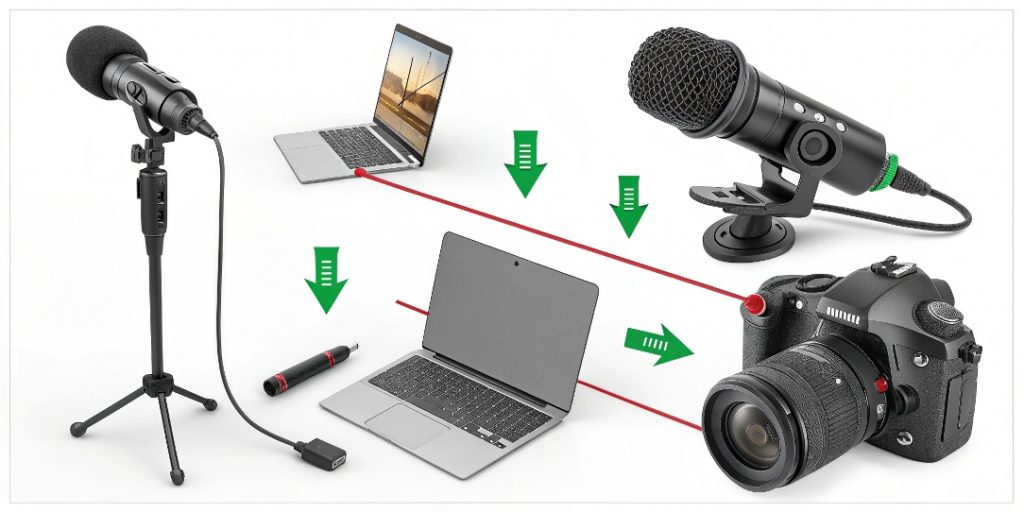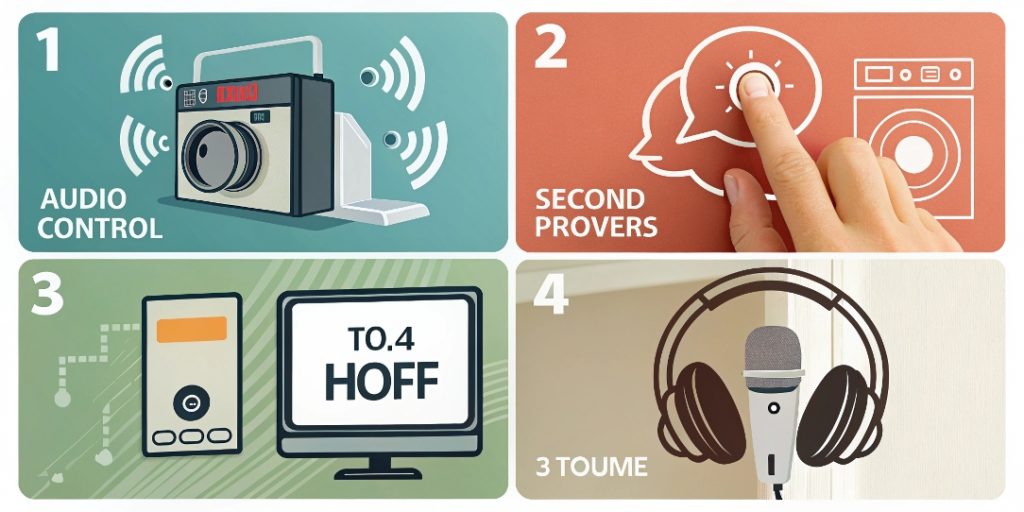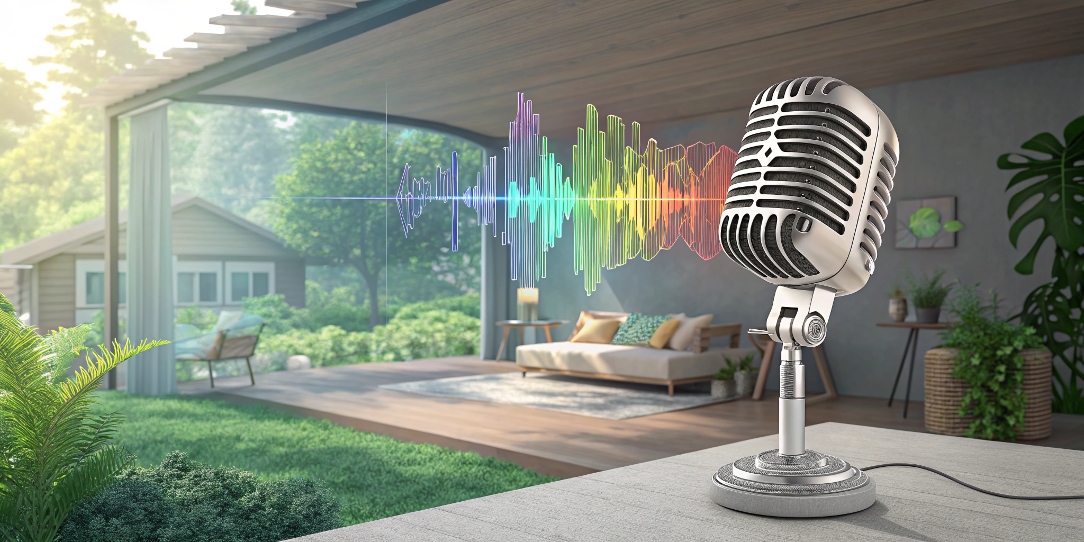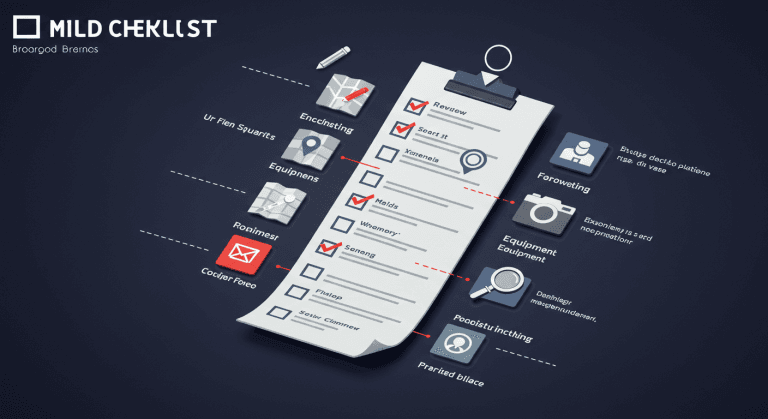Clean Audio for Video: Record Pro Sound Easily
You might have a video with incredible visuals, but if the audio is noisy, echoing, or incomprehensible, all the magic simply vanishes! Quality sound is the foundation of a professional video, and it starts long before editing. </h2>
We’ve discussed how to plan your script and visualize your shots, and the importance of lighting. Now, it’s time for the silent but fundamental hero: audio. Poor sound (noise, echo, low volume) is one of the main mistakes that ruin a video, and it’s much harder to fix in post-production than it seems.
At EdicionVideoPro, we know that clean audio is half the battle won. Putting in a little extra effort during the recording phase will save you countless hours of frustration in the editing suite (and might prevent your video from being incomprehensible!). This guide will give you practical tips to capture professional sound, both indoors and outdoors, without needing extremely expensive equipment.
The Golden Rule of Audio: GET CLOSE TO THE MICROPHONE!
This is the most important lesson of all. No matter what microphone you use, if it’s far from the sound source (the speaker’s mouth, the object making noise), it will capture more background noise than the desired voice or sound.
- Voiceover: The microphone should be very close to your mouth, about 6-8 inches (15-20 cm).
- Interviews/Dialogue: Position the mic as close to the speaker as possible, but out of frame.
Choosing Your Microphone (Not the Most Expensive, But the Right One)

You don’t need a recording studio, but you do need the right type of mic for your situation.
Built-in Microphones (Camera/Phone)
- Pros: Always available.
- Cons: Tend to pick up a lot of ambient noise and sound “distant” or “boxy” unless you’re very close. They’re omnidirectional, capturing everything!
- When to Use (only if no other option): Very close to the subject, in a completely silent environment.
Lavalier Microphones (Lavs)
- Pros: Excellent for clear voice capture due to their proximity to the mouth. Discreet. Very affordable options available (wired for phone/camera, or wireless).
- Cons: Can pick up clothing rustle or if the subject turns a lot.
- Ideal for: Interviews, vlogs, on-camera presentations for a single person, podcasts.
USB Desktop Microphones
- Pros: Good quality for voiceovers, podcasts, or stationary recordings. Easy to connect to your computer.
- Cons: Not portable, require a stable desk and a silent environment.
- Ideal for: Tutorial voiceovers, home studio recordings.
Shotgun Microphones
- Pros: Highly directional, capturing sound from the front and rejecting noise from the sides and rear. Often mounted on cameras or boom poles.
- Cons: Require good aim (pointing at the subject) and often a boom operator.
- Ideal for: Recordings where you can’t get a lavalier close (films, documentaries, events).
Practical Tips for Recording Clean Audio (Without Being a Sound Engineer!)

1. Control Your Recording Environment
- Silence is Golden!: Before recording, listen! Turn off AC, fans, refrigerators, washing machines. Close windows and doors to block outside noise.
- Indoors: Avoid empty rooms with hard surfaces (bathrooms, kitchens). Look for spaces with furniture, rugs, curtains, cushions… They absorb sound and reduce echo or reverb. Hanging thick blankets on walls can help.
- Outdoors: Choose quieter times and locations. Avoid busy streets, construction zones, or windy areas.
2. Monitor Your Audio (ESSENTIAL!)
- Wear Headphones: ALWAYS record with headphones plugged into your camera or recorder. This way you’ll hear exactly what the microphone is picking up and can detect noises, echoes, or distortions that you wouldn’t notice otherwise. It’s the best way to prevent issues!
3. Adjust Recording Levels (Gain)
- Not Too Low, Not Too High: Adjust the gain on your microphone or camera so that volume peaks (the loudest parts, e.g., a strong voice) reach approximately -12dB on your camera/recorder’s meter.
- Avoid the Red (Clipping)!: If the bars hit 0dB or enter the red zone, the sound distorts, and that audio is unrecoverable. It’s better to record a bit lower and boost it in editing than to record clipped audio.
4. Record “Room Tone” or Ambient Sound
- What is it? This is 30-60 seconds of complete silence in your recording environment, with no one talking or moving.
- What’s it for? All rooms have subtle background noise. If you record it, you can use it in editing to fill small gaps where you removed noise or dialogue, making the background audio consistent and transitions smoother. It’s essential for a clean audio mix!
5. Reduce Wind Noise (Outdoors)
- Wind Protection: Use “deadcats” (furry covers) or foam windscreens on your microphone. They drastically reduce wind noise on the microphone.
- Positioning: Position the subject or mic so that wind doesn’t hit it directly.
Common Audio Recording Mistakes to Avoid (And How They Impact Editing!)
- Microphone Too Far Away: Results in distant audio with too much ambient noise, hard to clean up.
- Ignoring Background Noise: Recording with constant noises (AC, traffic) that are very difficult to remove in post-production.
- Not Monitoring: Not using headphones means not detecting issues until it’s too late (in editing).
- Recording with Levels Too High (Clipping): Distortion is permanent and cannot be fixed.
- Not Recording Room Tone: Makes smooth audio transitions difficult in editing.
EdicionVideoPro Tip: Prevention is key! If the audio is poorly recorded from the source, post-production can make improvements (noise reduction, EQ), but not miracles. Clipped audio or audio with severe echo is almost impossible to salvage professionally.
Need Impeccable Sound for Your Videos?
Recording quality audio is a skill refined with practice. But if your project is crucial, your audio is complex, or you simply need a professional result without the learning curve, EdicionVideoPro is here to help. We have the experience and advanced tools to ensure your video’s sound is as impeccable as its visuals.
Ensure crystal-clear audio for your project, contact us.
Frequently Asked Questions (FAQ) – Audio Recording
(Format for RankMath “FAQ” block)
Q: Can I use my phone’s mic to record professional audio?
A: Yes, under certain conditions: 1) The phone must be VERY close to the mouth (ideally using a lavalier mic connected to the phone). 2) The environment must be EXTREMELY quiet and echo-free. In those conditions, you can get surprisingly good audio.
Q: What is “Clipping” in audio?
A: It’s when the audio signal’s volume is so high that it exceeds the recording equipment’s (camera or recorder) capacity. The result is a harsh, “broken” distortion that appears as a constant red on the meter. It’s audio’s biggest enemy and cannot be fixed.
Q: How do I record audio if I’m alone and need a shotgun mic?
A: If you don’t have a boom operator, you can mount the shotgun mic on top of your camera (on the hot shoe) if it’s designed for that, or on a mini-tripod/light stand close to the subject, pointing directly at their mouth. Always monitor with headphones.
Conclusion: Your Audio is Your Calling Card
Don’t underestimate the power of good audio. Dedicating time to pre-production and applying these basic recording tips will transform your video’s quality. Getting the microphone closer, controlling the environment, monitoring with headphones, and adjusting levels are practices that will set you apart.
Remember: quality audio recording is the foundation. Good audio editing (mixing and cleanup) can only improve what’s already well-recorded.
Put on your headphones, record with intention, and make your videos not just look great, but sound incredible! And if you need a sound expert, EdicionVideoPro is here to help.


